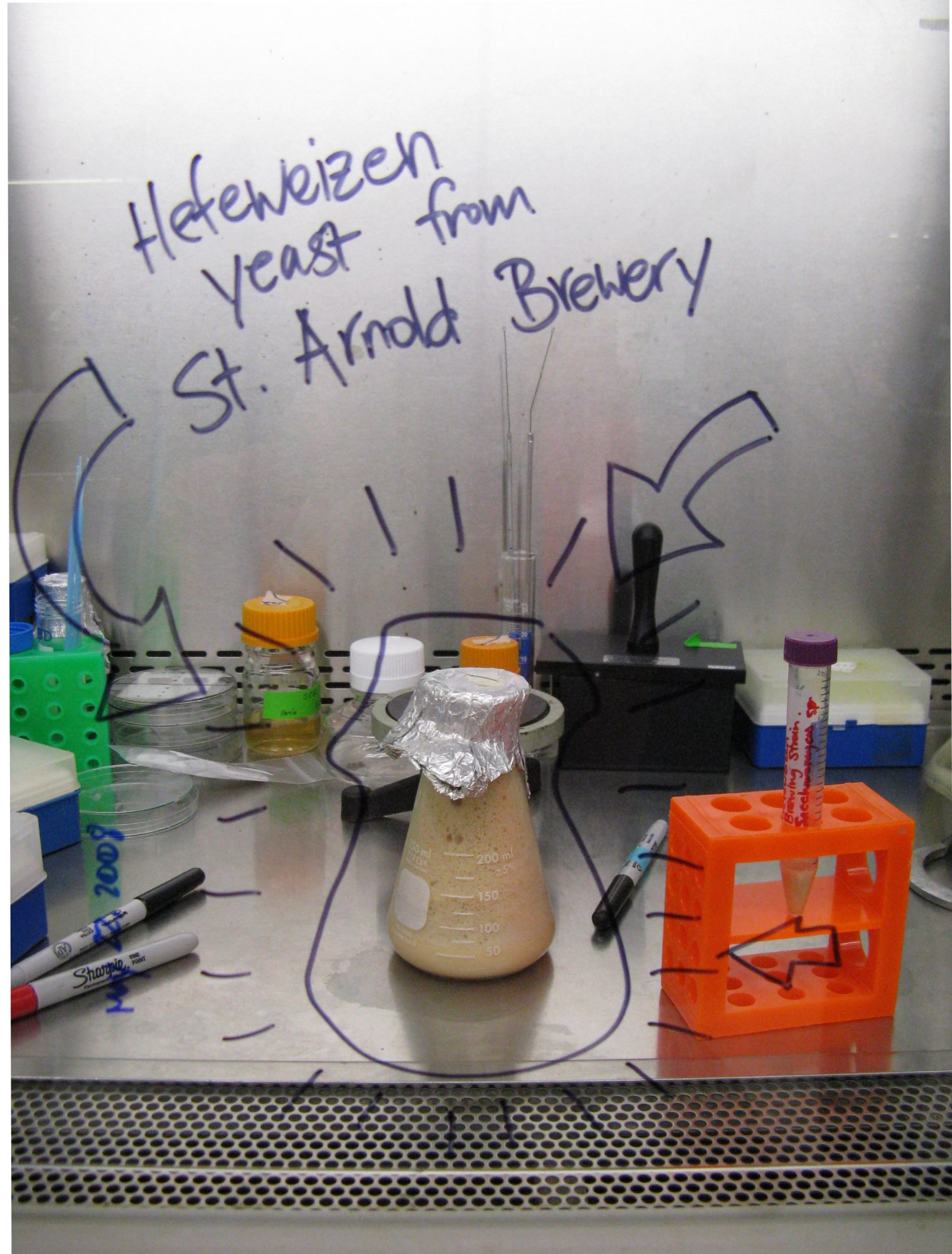From 2008.igem.org
(Difference between revisions)
|
|
| Line 61: |
Line 61: |
| | {|align="left" style="background-color:#FFFF99; text-align:left" border="1" cellpadding="0" width="45%" | | {|align="left" style="background-color:#FFFF99; text-align:left" border="1" cellpadding="0" width="45%" |
| | | | | | |
| - | *Our cellular brewing chassis can be best described by its use in St. Arnold's hefeweizen beer. This is top fermenting yeast which causes a great deal of gas induced convection during primary brewing. This will help to keep our yeast suspended and well-mixed. Additionally, hefeweizen beers are commonly served unfiltered, allowing for the consumption of whole yeast cells. We postulate will dramatically increase the amount of available resveratrol. Hefeweizen beers are said to have "light citrus notes over a full bodied breadiness". | + | *Our cellular brewing chassis can be best described by its use in St. Arnold's hefeweizen beer. This is top fermenting yeast which causes a great deal of gas induced convection during primary brewing. This will help to keep our yeast suspended and well-mixed. Additionally, hefeweizen beers are commonly served unfiltered, allowing for the consumption of whole yeast cells. We postulate this will dramatically increase the amount of resveratrol available for consumption. Hefeweizen beers are said to have "light citrus notes over a full bodied breadiness". |
| | |} | | |} |
| | [[Image: SAB_Hefe.png|right|175px]] | | [[Image: SAB_Hefe.png|right|175px]] |
Revision as of 03:34, 30 October 2008


|

OUR TEAM ::: SUMMARY ::: BACKGROUND :::
STRATEGY ::: CONSTRUCTS ::: RESULTS ::: ONGOING WORK
Pathway Design for Resveratrol Biosynthesis
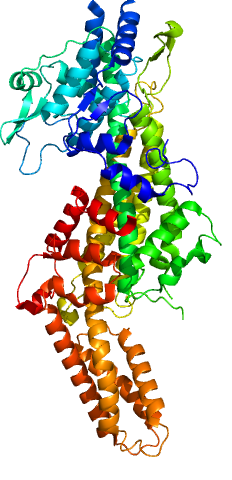 [http://www.rcsb.org/pdb/explore.do?structureId=1T6P TAL] monomer. - [http://www.ncbi.nlm.nih.gov/entrez/viewer.fcgi?db=nucleotide&val=169745 Tyrosine Ammonia-Lyase] (TAL, [http://partsregistry.org/wiki/index.php?title=Part:BBa_K122010 BBa_K122010]) - TAL catalyzes the conversion of L-tyrosine to p-coumaric acid and ammonia. TAL also exhibits Phenylalanine Ammonia-Lyase (PAL) activity, converting L-phenylalanine to trans-cinnamic acid and ammonia. Our work has focused on using [http://www.atcc.org/ATCCAdvancedCatalogSearch/ProductDetails/tabid/452/Default.aspx?ATCCNum=36575&Template=fungiYeast Rhodotorula glutinis] TAL because its ratio of TAL to PAL activity is high compared to other TAL homologs. In addition, previous studies have shown that this enzyme can be expressed as a functional protein in Saccharomyces cerevisiae and Escherichia coli. While the p-coumaric acid produced by TAL will serve as a substrate for resveratrol biosynthesis, the trans-cinnamic acid is expected to add a "floral" and "honey-like" bouquet to the beer.
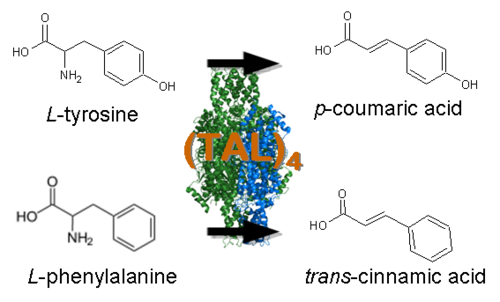
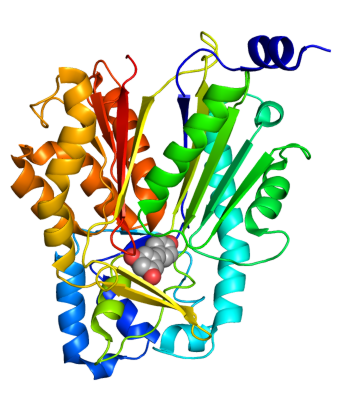 [http://www.rcsb.org/pdb/explore.do?structureId=1Z1F Peanut STS] monomer bound to resveratrol. - [http://www.ncbi.nlm.nih.gov/entrez/viewer.fcgi?val=NM_001084228.1 4-coumarate CoA ligase] :: [http://www.ncbi.nlm.nih.gov/entrez/viewer.fcgi?tool=portal&db=nuccore&term=&query_key=18&dopt=gb&dispmax=20&page=1&qty=1&WebEnv=1BAyWdNufvUWxpNM-oKD-9JoRgEPTXzU_kF02A2hfcePWB3nxyPvHO3gqlDJksRdZq9GmTDHNDmKEFuabzP4VKB%40263F5D1B8F754EA0_0062SID&WebEnvRq=1 Stilbene Synthase] Fusion Protein (4CL:STS, [http://partsregistry.org/wiki/index.php?title=Part:BBa_K122005 BBa_K122005]) - This enzyme fusion is comprised of Arabidopsis thaliana 4-coumarate-CoA ligase (4CL), which catalyzes the conversion of p-coumaric acid to 4-coumaroyl-CoA, and Vitis vinifera Stilbene Synthase, which catalyzes the condensation of resveratrol from 4-coumaroyl-CoA and three malonyl-CoA molecules. This 4CL:STS fusion protein was selected for our project because it has been shown to more efficiently produce resveratrol than coexpression of the proteins separately (possibly due to substrate channeling).
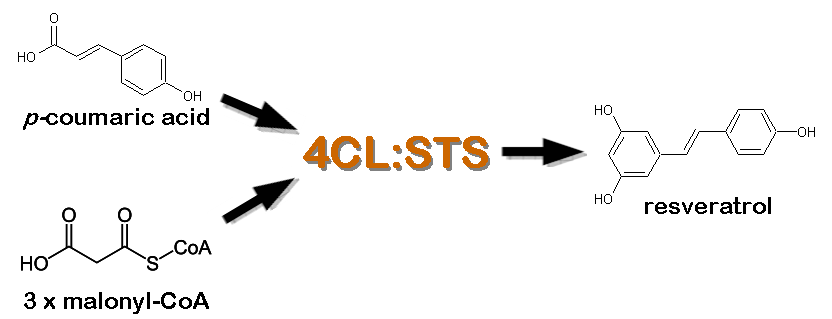
Circuit Design for Recombination in Yeast
 [http://partsregistry.org/wiki/index.php?title=Part:BBa_K122020 BBa_K122020]. - Our design goal was to construct a circuit that would propagate through several generations without a selection pressure and be highly expressed during all stages of fermentation. To address these goals, we constructed three expression cassettes that, when concatenated, would integrate genomically into a highly transcribed locus, have an inducible selectable marker, and highly express the resveratrol pathway under anaerobic conditions.
- [http://partsregistry.org/wiki/index.php?title=Part:BBa_K122012 Cassette 1] - Anaerobically induced expression of 4CL:STS
- [http://partsregistry.org/wiki/index.php?title=Part:BBa_K122000 pPGK1] - Serves the dual purpose of 5' homologous recombination region and anaerobically induced promoter.
- [http://partsregistry.org/wiki/index.php?title=Part:BBa_K122005 4CL:STS] - Converts p-coumaric acid and 3 malonyl-CoA molecules to resveratrol.
- [http://partsregistry.org/wiki/index.php?title=Part:BBa_K122003 tCYC1] - Bi-directional transcriptional stop.
|
- [http://partsregistry.org/wiki/index.php?title=Part:BBa_K122015 Cassette 2] - Inducible expression of Bleocin resistance.
- [http://partsregistry.org/wiki/index.php?title=Part:BBa_K122001 pGAL1 TetO ZeoR] - Provides galactose inducible, TetR repressible, Zeocin/Bleocin resistance. This part will allow us to select for recombinants.
- [http://partsregistry.org/wiki/index.php?title=Part:BBa_K122004 tADH1] - Bi-directional transcriptional stop. Strategically placed downstream of ZeoR and upstream of pADH1 to prevent erroneous recombination at those regions.
|
- [http://partsregistry.org/wiki/index.php?title=Part:BBa_K122021 Cassette 3] - Constitutive expression of TAL
- [http://partsregistry.org/wiki/index.php?title=Part:BBa_K122004 pADH1] - Constitutive promoter. Strategically placed to prevent erroneous recombination with tADH1.
- [http://partsregistry.org/wiki/index.php?title=Part:BBa_K122005 TAL] - Converts L-tyrosine to p-coumaric acid and L-phenylalanine to trans-cinnamic acid.
- [http://partsregistry.org/wiki/index.php?title=Part:BBa_K122013 tPGK1] - Dual purpose of 3' homologous recombination region and bi-directional transcriptional terminator.
|
Selection of Brewing Strain
 [http://www.saintarnold.com/ http://www.saintarnold.com/]
- Our cellular brewing chassis can be best described by its use in St. Arnold's hefeweizen beer. This is top fermenting yeast which causes a great deal of gas induced convection during primary brewing. This will help to keep our yeast suspended and well-mixed. Additionally, hefeweizen beers are commonly served unfiltered, allowing for the consumption of whole yeast cells. We postulate this will dramatically increase the amount of resveratrol available for consumption. Hefeweizen beers are said to have "light citrus notes over a full bodied breadiness".
|
|
OUR TEAM :::
SUMMARY ::: INTRODUCTION ::: STRATEGY ::: RESULTS ::: ONGOING WORK
|
|
 "
"









